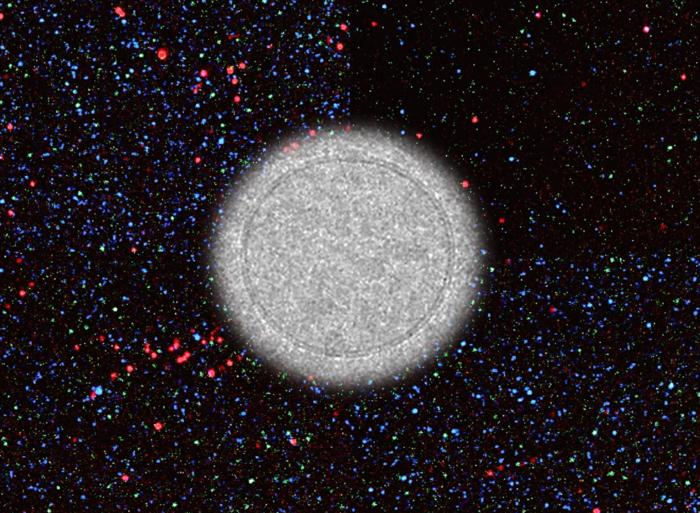Reviewed by Danielle Ellis, B.Sc.Jul 10 2023
Three previously undiscovered membrane proteins in ovarian cancer have been discovered by a study led by Nagoya University in Japan. The research was successful in trapping the proteins using a novel technology made of nanowires with a polyketone coating, revealing a new detection method for ovarian cancer detection.
 Extracellular vesicles (EVs) are vesicles with lipid-bilayer structures (shown in center), and three proteins expressed on small EVs called exosomes (shown in red, green, blue) are more suitable biomarkers to detect ovarian cancer than the larger extracellular vesicle. Image Credit: Akira Yokoi
Extracellular vesicles (EVs) are vesicles with lipid-bilayer structures (shown in center), and three proteins expressed on small EVs called exosomes (shown in red, green, blue) are more suitable biomarkers to detect ovarian cancer than the larger extracellular vesicle. Image Credit: Akira Yokoi
Ovarian cancer is difficult to identify in the early stages, when it is most easily treated, hence the development of novel biomarkers is crucial for its detection. Extracellular Vesicles (EVs), notably tiny proteins secreted from the tumor known as exosomes, are one way to find cancer.
These proteins can be isolated from bodily fluids like blood, urine, and saliva since they can be located outside of cancer cells. But since there are not any good biomarkers for ovarian cancer detection, the application of these indicators is constrained.
High-grade serous carcinoma (HGSC), the most prevalent type of ovarian cancer, was the source of the EVs that were extracted and analyzed by a team of researchers led by Akira Yokoi (he, him) of Nagoya University Graduate School of Medicine and Mayu Ukai (she, her) at the Institute for Advanced Research.
Their study was initially difficult.
The validation steps for the identified proteins were tough because we had to try a lot of antibodies before we found a good target. As a result, it became clear that the small and medium/large EVs are loaded with clearly different molecules. Further investigation revealed that small EVs are more suitable biomarkers than the medium and large type. We identified the membrane proteins FRα, Claudin-3, and TACSTD2 in the small EVs associated with HGSC.”
Akira Yokoi, Researcher, Graduate School of Medicine, Nagoya University
Now that the proteins had been identified, the researchers looked into whether they could trap EVs in a way that would allow them to detect the presence of cancer. Takao Yasui of Nagoya University’s Graduate School of Engineering collaborated with Dr Inokuma of the Japan Science and Technology Agency to synthesize polyketone chain-coated nanowires (pNWs). This method was perfect for separating exosomes from blood samples.
Yokoi added, “pNW creation was tough. We must have tried 3-4 different coatings on the nanowires. Although polyketones are a completely new material to use to coat this type of nanowire, in the end, they were such a good fit.”
“Our findings showed that each of the three identified proteins is useful as a biomarker for HGSCs. The results of this research suggest that these diagnostic biomarkers can be used as predictive markers for specific therapies. Our results allow doctors to optimize their therapeutic strategy for ovarian cancer, therefore, they may be useful for realizing personalized medicine,” Yokoi concluded.
Source:
Journal reference:
Yokoi, A., et al. (2023). Identifying high-grade serous ovarian carcinoma–specific extracellular vesicles by polyketone-coated nanowires. Science Advances. doi.org/10.1126/sciadv.ade6958